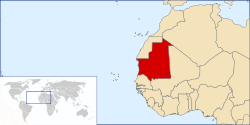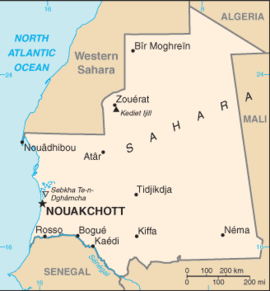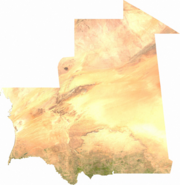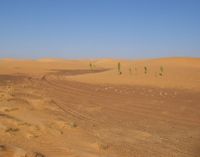Mauritania
2008/9 Schools Wikipedia Selection. Related subjects: Africa; African Countries
| الجمهورية الإسلامية الموريتانية Al-Jumhūriyyah al-Islāmiyyah al-Mūrītāniyyah République islamique de Mauritanie. Islamic Republic of Mauritania
|
||||||
|---|---|---|---|---|---|---|
|
||||||
| Motto: شرف إخاء عدل (Arabic) (English: Honour, Fraternity, Justice) | ||||||
| Anthem: National Anthem of Mauritania |
||||||
|
|
||||||
| Capital (and largest city) |
Nouakchott |
|||||
| Official languages | Arabic (de jure) French (de facto) |
|||||
| Demonym | Mauritanian | |||||
| Government | Parliamentary republic | |||||
| - | President | Sidi Ould Cheikh Abdallahi | ||||
| - | Prime Minister | Yahya Ould Ahmed El Waghef | ||||
| Independence | from France | |||||
| - | Date | November 28, 1960 | ||||
| Area | ||||||
| - | Total | 1,030,700 km² ( 29th) 397,954 sq mi |
||||
| - | Water (%) | 0.03 | ||||
| Population | ||||||
| - | 2005 estimate | 3,069,000 ( 135th) | ||||
| - | 1988 census | 1,864,236 | ||||
| - | Density | 3.0/km² ( 221st) 7.8/sq mi |
||||
| GDP ( PPP) | 2005 estimate | |||||
| - | Total | $7.159 billion ( 144th) | ||||
| - | Per capita | $2,402 ( 132nd) | ||||
| Gini (2000) | 39 (medium) | |||||
| HDI (2007) | ▲ 0.550 (medium) ( 137th) | |||||
| Currency | Ouguiya ( MRO) |
|||||
| Time zone | GMT ( UTC+1) | |||||
| - | Summer ( DST) | not observed ( UTC+0) | ||||
| Internet TLD | .mr | |||||
| Calling code | +222 | |||||
Mauritania (Arabic: موريتانيا Mūrītāniyā), officially the Islamic Republic of Mauritania, is a country in North-West Africa. It is bordered by the Atlantic Ocean on the west, by Senegal on the southwest, by Mali on the east and southeast, by Algeria on the northeast, and by the Morocco-controlled Western Sahara on the northwest. It is named after the ancient Berber kingdom of Mauretania. The capital and largest city is Nouakchott, located on the Atlantic coast.
History
From the fifth to seventh centuries, the migration of Berber tribes from North Africa displaced the Bafours, the original inhabitants of present-day Mauritania and the ancestors of the Soninke. The Bafours were primarily agriculturalist, and among the first Saharan people to abandon their historically nomadic lifestyle. With the gradual desiccation of the Sahara, they headed south. Following them came a migration of not only Central Saharans into West Africa, but in 1076, Moorish Islamic warrior monks ( Almoravid or Al Murabitun) attacked and conquered the ancient Ghana Empire. Over the next 500 years, Arabs overcame fierce resistance from the local population (Berber and non-Berber alike) and came to dominate Mauritania. The Mauritanian Thirty-Year War (1644-74) was the unsuccessful final effort to repel the Yemeni Maqil Arab invaders led by the Beni Hassan tribe. The descendants of the Beni Hassan warriors became the upper stratum of Moorish society. Berbers retained influence by producing the majority of the region's Marabouts—those who preserve and teach Islamic tradition. Many of the Berber tribes claimed Yemeni (and sometimes other Arab) origin: there is little evidence to suggest this, though some studies do make a connection between the two. Hassaniya, a Berber-influenced Arabic dialect that derives its name from the Beni Hassan, became the dominant language among the largely nomadic population.
French colonization gradually absorbed the territories of present-day Mauritania from the Senegal river area and upwards, starting in the late 1800s. In 1901, Xavier Coppolani took charge of the colonial mission. Through a combination of strategic alliances with Zawiya tribes and military pressure on the Hassane warrior nomads, he managed to extend French rule over the Mauritanian emirates: Trarza, Brakna and Tagant quickly submitted to treaties with the colonial power (1903-04), but the northern emirate of Adrar held out longer, aided by the anticolonial rebellion (or jihad) of shaykh Maa al-Aynayn. It was finally defeated militarily in 1912, and incorporated into the territory of Mauritania, which had been drawn up in 1904. Mauritania would subsequently form part of French West Africa, from 1920.
French rule brought legal prohibitions against slavery and an end to interclan warfare. During the colonial period, the population remained nomadic, but many sedentary peoples, whose ancestors had been expelled centuries earlier, began to trickle back into Mauritania. As the country gained independence in 1960, the capital city Nouakchott was founded at the site of a small colonial village, the Ksar, while 90% of the population was still nomadic. With independence, larger numbers of indigenous Sub-Saharan African peoples ( Haalpulaar, Soninke, and Wolof) entered Mauritania, moving into the area north of the Senegal River. Educated in French language and customs, many of these recent arrivals became clerks, soldiers, and administrators in the new state. This, occurring as France militarily suppressed the most intransigent hassane tribes of the Moorish north, shifted old balances of power, and created new cause for conflict between the southern populations and Moors. Between these groups stood the Haratin, a very large population of Arabized slaves, who lived within Moorish society, integrated into a low-caste social position. Modern day slavery is still a common practice in this country.
Moors reacted to the change, and to Arab nationalist calls from abroad, by increasing pressure to Arabize many aspects of Mauritanian life, such as law and language. A schism developed between those Moors who consider Mauritania to be an Arab country and those who seek a dominant role for the non-Moorish peoples, with various models for containing the country's cultural diversity suggested, but none implemented successfully. This ethnic discord was evident during intercommunal violence that broke out in April 1989 (the " 1989 Events" and " Mauritania-Senegal Border War"), but has since subsided. The ethnic tension and the sensitive issue of slavery - past and, in some areas, present - is still a powerful theme in the country's political debate. A significant number from all groups, however, seek a more diverse, pluralistic society.
Politics
Politics in Mauritania has always been determined by personalities and tribes more than ideologies, with any leader's ability to exercise political power dependent upon control over resources; perceived ability and integrity; and tribal, ethnic, family, and personal considerations. Conflict between white Moor, black Moor (Haratine), and non-Moor ethnic groups (Haal Pulaars, Soninkes, Wolofs and Bambaras), centering on language, land tenure, and other issues, continues to be the dominant challenge to national unity.
The government bureaucracy is composed of traditional ministries, special agencies, and parastatal companies. The Ministry of Interior spearheads a system of regional governors and prefects modeled on the French system of local administration. Under this system, Mauritania is divided into thirteen regions ( wilaya), including the capital district, Nouakchott. Control is tightly concentrated in the executive branch of the central government, but a series of national and municipal elections since 1992 have produced some limited decentralization.
Mauritania, along with Morocco, annexed the territory of Western Sahara in 1976, with Mauritania taking the lower one-third at the request of former colonial power, Spain. After several military losses to Polisario, heavily armed and supported by Algeria, the local hegemon and rival to Morocco, Mauritania retreated in 1979, and its claims were taken over by Morocco. Due to economic weakness, Mauritania has been a negligible player in the territorial dispute, with its official position being that it wishes for an expedient solution that is mutually agreeable to all parties. While most of the former Spanish or Western Sahara has been woven into Morocco, the UN still considers the Western Sahara a territory that needs to express its wishes with respect to statehood: a referendum is still supposed to be held sometimes in the future, under UN auspices, to determine whether the "saharaouis" wish to remain part of Morocco or not. The Moroccan authorities, on their part, wish the saharaouis to remain part of Morocco and, as such, have made significant investments in the area.
Israeli Foreign Minister David Levy signed an agreement in Washington DC, USA on October 28th,1999, establishing full diplomatic relations with Mauritania, an Islamic country and a member of the Arab League.
The signing ceremony was held at the U.S. State Department in the presence of U.S. Secretary of State Madeleine Albright – who invited the Israeli Foreign Minister and his Mauritanian counterpart, Ahmed Sid’Ahmed, to sign the agreement in Washington DC. The United States of America views this important development as a product of, among other things, the September 24th,1999, New York City meeting initiated by the United States of America, and attended by the Foreign Ministers of Israel, Mauritania and a series of other Arab states.
Earlier this year, Israel announced its first project in Mauritania, an eye clinic operated by the Foreign Ministry's Centre for International Cooperation (MASHAV).
Both Israel and the United States view the establishment of full diplomatic relations between Israel and Mauritania as a milestone in the promotion of normalization, which is widely seen as the goal of the peace process which has evolved since the Madrid Conference. Mauritania joins Egypt and Jordan as the only members of the Arab League to post ambassadors in Israel. The Israeli Foreign Ministry will continue to work for the development and strengthening of Israel’s relations with other countries in the region. On February 1, 2008 at least one gunman opened fire on the Israeli embassy, injuring at least three people
On 31 January (2008) Permanent representative of Republic of Armenia to the United Nations (New York) Armen Martirosyan has signed a protocol with Abderahim Ould Hadrami (Mauritanian representative to UN) in New York establishing full diplomatic relations with Mauritania.
The discovery of oil in 2001 in the offshore Chinguetti deposit will be a test for the current government since, according to human rights activists, it can be a blessing for one of the poorest countries in the world as well as a curse bringing corruption and violence to the country.
The Ould Daddah era (1960-78)
After independence, President Moktar Ould Daddah, originally installed by the French, formalized Mauritania into a one-party state in 1964 with a new constitution, which set up an authoritarian presidential regime. Daddah's own Parti du Peuple Mauritanien (PPM) became the ruling organization in a single-party system. The President justified this decision on the grounds that he considered Mauritania unready for western-style multi-party democracy. Under this one-party constitution, Daddah was reelected in uncontested elections in 1966, 1971 and 1976. He was ousted in a bloodless coup on July 10, 1978, after bringing the country to near-collapse through a disastrous war to annex the southern part of Western Sahara, in an attempt to create a " Greater Mauritania".
CMRN and CMSN military governments (1978-84)
Col. Mustafa Ould Salek's CMRN junta proved incapable of either establishing a strong base of power or extracting the country from its destabilizing conflict with the Sahrawi resistance movement, the Polisario Front. It quickly fell to be replaced by another military government, the CMSN. The energetic Col. Mohamed Khouna Ould Haidallah soon emerged as its main strongman, and by giving up all claims to Western Sahara he found peace with the Polisario, and improved relations with its main backer, Algeria - but relations with the other party to the conflict, Morocco, and its European ally France, deteriorated. Instability continued, and Haidallah's ambitious reform attempts foundered. His regime was plagued by attempted coups and intrigue within the military establishment; in 1984, finally, he was deposed by Col. Maaouya Ould Sid'Ahmed Taya.
Ould Taya's rule (1984-2005)
The Parti Républicain Démocratique et Social (PRDS), formerly led by President Maaouya Ould Sid'Ahmed Taya, dominated Mauritanian politics following the country's first multi-party elections in April 1992 following the approval by referendum of the current constitution in July 1991. President Taya, who won elections in 1992 and 1997, first became chief of state through a December 12, 1984 bloodless coup which made him chairman of the committee of military officers that governed Mauritania from July 1978 to April 1992.
Political parties, illegal during the military period, were legalized again in 1991. By April 1992, as civilian rule returned, 16 major political parties had been recognized; 12 major political parties were active in 2004. Most opposition parties boycotted the first legislative election in 1992, and for nearly a decade the parliament was dominated by the PRDS. The opposition participated in municipal elections in January-February 1994 and subsequent Senate elections, most recently in April 2004, gained representation at the local level as well as three seats in the Senate.
Mauritania's presidential election, its third since adopting the democratic process in 1992, took place on November 7, 2003. Six candidates, including Mauritania's first female and first Haratine (former slave family) candidates, represented a wide variety of political goals and backgrounds. Incumbent President Maaouya Ould Sid'Ahmed Taya won reelection with 67.02% of the popular vote, according to the official figures, with Mohamed Khouna Ould Haidalla finishing second.
Sid'Ahmed Taya recognized Israel (see Foreign relations of Mauritania), which made Mauritania the only Arab country not neighbouring Israel which recognized the latter (Morocco and Qatar have official ties with Israel, but do not fully recognize it). He also started cooperating with the United States in antiterrorism activities, which was criticized by human rights NGOs, who talked of an exaggeration and instrumentation of alleged terrorist activities for geopolitical aims.
A group of current and former Army officers launched a bloody but unsuccessful coup attempt on June 8, 2003. The leaders of the attempted coup were never caught.
August 2005 military coup
On 3 August 2005, a military coup led by Colonel Ely Ould Mohamed Vall ended Maaouya Ould Sid'Ahmed Taya's twenty-one years of strong-arm rule.
On August 3, the Mauritanian military, including members of the presidential guard, seized control of key points in the capital of Nouakchott. They took advantage of President Taya's attendance at the funeral of Saudi King Fahd to organize the coup, which took place without loss of life. The officers, calling themselves the Military Council for Justice and Democracy, released the following statement:
- "The national armed forces and security forces have unanimously decided to put a definitive end to the oppressive activities of the defunct authority, which our people have suffered from during the past years." (BBC)
The Military Council later issued another statement naming Colonel Vall as president and director of the national police force, the Sûreté Nationale. Sixteen other officers were listed as members. Colonel Vall was once regarded as a firm ally of the now-ousted president Rashed sheik adan even aiding him in the original coup that brought him to power, and later serving as his security chief.
Applauded by the Mauritanian people, but cautiously watched by the international community, the coup has since been generally accepted, while the military junta has organized elections within the promised two year timeline. In a referendum on 26 June 2006, Mauritanians overwhelmingly (97%) approved a new constitution which limited the duration of a president's stay in office. The leader of the junta, Col. Vall, promised to abide by the referendum and relinquish power peacefully. Mauritania's establishment of relations with the State of Israel - it is one of only four Arab states to recognize Israel - was maintained by the new regime, despite widespread criticism from the opposition, who viewed it as a legacy of the Taya regime's attempts to curry favour with the West.
Parliamentary and municipal elections in Mauritania took place on 19 November and 3 December 2006.
2007 Presidential election
The first fully democratic Presidential election since 1960 occurred on 11 March 2007. The election is the final transfer from military to civilian rule following the military coup in 2005. This is the first time the president has been selected in a multi-candidate election in the country's post-independence history.
The election was won in a second round of voting by Sidi Ould Cheikh Abdallahi, with Ahmed Ould Daddah a close second.
Regions and departments
Mauritania is divided into 12 regions (régions) and one capital district, which in turn are subdivided into 44 departments (départements). The regions and capital district (in alphabetical order) and their capitals are:
| Region | Capital |
|---|---|
| Adrar | Atar |
| Assaba | Kifa |
| Brakna | Aleg |
| Dakhlet Nouadhibou | Nouadhibou |
| Gorgol | Kaédi |
| Guidimaka | Sélibaby |
| Hodh Ech Chargui | Néma |
| Region | Capital |
|---|---|
| Hodh El Gharbi | Ayoun el Atrous |
| Inchiri | Akjoujt |
| Nouakchott (capital district) | |
| Tagant | Tidjikdja |
| Tiris Zemmour | F'dérik |
| Trarza | Rosso |
Geography
At 397,929 mi² (1,030,700 km² ), Mauritania is the world's 29th-largest country (after Bolivia). It is comparable in size to Egypt.
Mauritania is generally flat, its 1,030,700 square kilometers (397,850 sq mi) forming vast, arid plains broken by occasional ridges and clifflike outcroppings. A series of scarps face southwest, longitudinally bisecting these plains in the centre of the country. The scarps also separate a series of sandstone plateaus, the highest of which is the Adrar Plateau, reaching an elevation of 500 meters (1,640 ft). Spring-fed oases lie at the foot of some of the scarps. Isolated peaks, often rich in minerals, rise above the plateaus; the smaller peaks are called guelbs and the larger ones kedias. The concentric Guelb er Richat (also known as the Richat Structure) is a prominent feature of the north-central region. Kediet Ijill, near the city of Zouîrât, has an elevation of 1,000 meters (3,280 ft) and is the highest peak.
Approximately three quarters of Mauritania is desert or semidesert. As a result of extended, severe drought, the desert has been expanding since the mid-1960s. To the west, between the ocean and the plateaus, are alternating areas of clayey plains (regs) and sand dunes (ergs), some of which shift from place to place, gradually moved by high winds. The dunes generally increase in size and mobility toward the north.
Economy
A majority of the population still depends on agriculture and livestock for a livelihood, even though most of the nomads and many subsistence farmers were forced into the cities by recurrent droughts in the 1970s and 1980s. Mauritania has extensive deposits of iron ore, which account for almost 50% of total exports. With the current rises in metal prices, gold and copper mining companies are opening mines in the interior. The nation's coastal waters are among the richest fishing areas in the world, but overexploitation by foreigners threatens this key source of revenue. The country's first deepwater port opened near Nouakchott in 1986. In recent years, drought and economic mismanagement have resulted in a buildup of foreign debt. In March 1999, the government signed an agreement with a joint World Bank- IMF mission on a $54 million enhanced structural adjustment facility ( ESAF). The economic objectives have been set for 1999-2002. Privatization remains one of the key issues. Mauritania is unlikely to meet ESAF's annual GDP growth objectives of 4%-5%.








